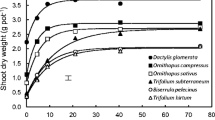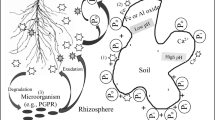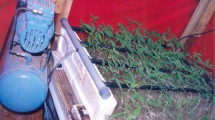Abstract
Background and aims
Australian herbaceous native species have evolved in phosphorus (P) impoverished soils. Our objective was to explore shoot and root adaptations of two of these species with potential to be developed as pasture plants, at low, moderate and high P supply after 4 and 7 weeks of growth.
Methods
A glasshouse experiment examined the effect of 5, 20 and 80 mg P kg−1 air-dry soil on growth, rhizosphere carboxylate content, and mineral nutrition of two Australian native perennials, Kennedia nigricans (Fabaceae) and Ptilotus polystachyus (Amaranthaceae), and the exotic Medicago sativa (Fabaceae).
Key results
Leaf P concentrations at P80 were 6, 14 and 52 mg P g−1 leaf dry weight for M. sativa, K. nigricans and P. polystachyus, respectively. As soil P concentration increased, rhizosphere carboxylate content decreased for M. sativa, increased and then decreased for K. nigricans and was unchanged for P. polystachyus. For all species, the contribution of malic acid declined at the second harvest. For all species and P treatments, the amount of rhizosphere carboxylates per unit root length decreased as root length of a plant increased. Plant P content was determined more by P uptake rate per unit root length and time than by root length. Uptake of Mo for all species, and uptake of K, Mg and Mn for P. polystachyus, increased with soil P concentration. Uptake of Fe and S was higher when the content of carboxylates in the rhizosphere was higher.
Conclusion
Root physiological adaptations (i.e. rhizosphere carboxylate content and P-uptake rate) are more important than morphological adaptations (i.e. root length and diameter) to enhance the uptake of P and cations.








Similar content being viewed by others
References
Argyriadis GA, Dijkshoorn W, Lampe JEM (1976) Level and origin of carboxylate in buckwheat. Plant Soil 44:669–681
Bell LW, Bennett RG, Ryan MH, Clarke H (2011) The potential of herbaceous native Australian legumes as grain crops: a review. Renew Agr Food Syst 26:72–91
Bhadoria PS, El Dessougi H, Liebersbach H, Claassen N (2004) Phosphorus uptake kinetics, size of root system and growth of maize and groundnut in solution culture. Plant Soil 262:327–336
Black CA (1968) Soil-plant relationships. 2nd edn. Wiley, New York. Department of Agronomy, Iowa
Blair GJ, Chinoim N, Lefroy RDB, Anderson GC, Crocker GJ (1991) A soil sulphur test for pastures and crops. Aust J Soil Res 29:619–626
Bolland MDA, Lewis DC, Gilkes RJ, Hamilton LJ (1997) Review of Australian phosphate rock research. Aust J Agr Res 37:845–859
Brennan RF, Webb MG, Crowhurst AM (2000) Yield responses of mulla mulla (Ptilotus exaltatus Nees.) seedlings to additions of nitrogen, potassium and phosphorus fertiliser. Aust J Exp Agr 40:867–871
Colwell JD (1965) An automatic procedure for the determination of phosphorus in sodium hydrogen carbonate extract of soil. Chem Ind 10:893–895
Conn S, Gilliham M (2010) Comparative physiology of elemental distributions in plants. Ann Bot 105:1081–1102
Cornish PS (2009) Phosphorus management on extensive organic and low-input farms. Crop Past Sci 60:105–115
Gahoonia TS, Nielsen NE (2004) Root traits as tools for creating phosphorus efficient crop varieties. Plant Soil 260:47–57
Ghannoum O, Conroy JP (2007) Phosphorus deficiency inhibits growth in parallel with photosynthesis in a C3 (Panicum laxum) but not two C4 (P. coloratum and Cenchrus ciliaris) grasses. Funct Plant Biol 34:72–81
Handreck KA (1997) Phosphorus requirements of Australian native plants. Aust J Soil Res 35:241–289
Hammond JP, Broadley MR, White PJ, King GJ, Bowen HC, Hayden R, Meacham MC, Mead A, Overs T, Spracklen WP, Greenwood DJ (2009) Shoot yield drives phosphorus use efficiency in Brassica oleracea and correlates with root architecture traits. J Exp Bot 60:1953–1968
Ho MD, Rosas JC, Brown KM, Lynch JP (2005) Root architectural tradeoffs for water and phosphorus acquisition. Funct Plant Biol 32:737–748
Jacob J, Lawlor DW (1991) Stomatal and mesophyll limitations of photosynthesis in phosphate deficient sunflower, maize and wheat plants. J Exp Bot 42:1003–1011
Jones DL (1998) Organic acids in the rhizosphere - a critical review. Plant Soil 205:25–44
Lambers H, Finnegan PM, Laliberté E, Pearse SJ, Ryan MH, Shane MW, Veneklaas EJ (2011) Phosphorus nutrition of Proteaceae in severely phosphorus-impoverished soils: are there lessons to be learned for future crops? Plant Physiol 156:1058–1066
Lambers H, Juniper D, Cawthray GR, Veneklaas EJ, Martínez-Ferri E (2002) The pattern of carboxylate exudation in Banksia grandis (Proteaceae) is affected by the form of phosphate added to the soil. Plant Soil 238:111–122
Liang Q, Cheng X, Mei M, Yan X, Liao H (2010) QTL analysis of root traits as related to phosphorus efficiency in soybean. Ann Bot 106:223–234
Lynch JP (2011) Root phenes for enhanced soil exploration and phosphorus acquisition: tools for future crops. Plant Physiol 156:1041–1049
Lynch JP, Ho MD (2005) Rhizoeconomics: carbon costs of phosphorus acquisition. Plant Soil 269:45–56
Marschner P, Crowley DE, Higashi RM (1997) Root exudation and physiological status of a root-colonizing fluorescent pseudomonas in mycorrhizal and nonmycorrhizal pepper (Capsicum annuum L.). Plant Soil 189:11–20
Marschner P, Crowley D, Rengel Z (2011) Rhizosphere interactions between microorganisms and plants govern iron and phosphorus acquisition along the root axis – model and research methods. Soil Biol Biochem 43:883–894
Motomizu S, Wakimoto T, Toei S (1983) Spectrophotometric determination of phosphate in river waters with molybdate and malachite green. Analyst 118:361–367
Neumann G, Martinoia E (2002) Cluster roots: an underground adaptation for survival in extreme environments. Trends Plant Sci 7:162–167
Norvell WA, Welch RM (1993) Growth and nutrient uptake by barley (Hordeum vulgare L. cv Herta): Studies using an N-(2-Hydroxyethyl) ethylenedinitrilotriacetic acid-buffered nutrient solution technique (I. Zinc Ion Requirements). Plant Physiol 101:619–625
Page V, Weisskopf L, Feller U (2006) Heavy metals in white lupin: uptake, root-to-shoot transfer and redistribution within the plant. New Phytol 171:329–341
Pang J, Tibbett M, Denton MD, Lambers H, Siddique KHM, Bolland MDA, Revell CK, Ryan MH (2010) Variation in seedling growth of 11 perennial legumes in response to phosphorus supply. Plant Soil 328:133–143
Pearse SJ, Veneklaas EJ, Cawthray G, Bolland MDA, Lambers H (2007) Carboxylate composition of root exudates does not relate consistently to a crop species’ ability to use phosphorus from aluminium, iron or calcium phosphate sources. New Phytol 173:181–190
Peñaloza E, Corcuera LJ, Martinez J (2002) Spatial and temporal variation in citrate and malate exudation and tissue concentration as affected by P stress in roots of white lupin. Plant Soil 241:209–221
Rayment GE, Higginson FR (1992) Australian laboratory handbook of soil and water chemical methods. Inkata Press, Melbourne
Richardson AE, Hadobas PA, Hayes JE (2000) Acid phosphomonoesterase and phytase activities of wheat (Triticum aestivum L.) roots and utilization of organic phosphorus substrates by seedlings grown in sterile culture. Plant Cell Environ 23:397–405
Rivett D, Tucker D, Jones G (1983) The chemical composition of seeds from some Australian plants. Aust J Agr Res 34:427–432
Ryan MH, Ehrenberg S, Bennett RG, Tibbett M (2009) Putting the P in Ptilotus: a phosphorus-accumulating herb native to Australia. Ann Bot 103:901–911
Ryan MH, McCully ME, Huang CX (2003) Location and quantification of phosphorus and other elements in fully hydrated, soil-grown arbuscular mycorrhizas: a cryo-analytical scanning electron microscopy study. New Phytol 160:429–441
Ryan MH, Tibbett M, Edmonds-Tibbett T, Suriyagoda LDB, Lambers H, Cawthray GR, Pang J (2012) Carbon trading for phosphorus gain: the balance between rhizosphere carboxylates and arbuscular mycorrhizal symbiosis in plant phosphorus acquisition. Plant, Cell Environ. In press.
Searle PL (1984) Berthelot or indophenol reaction and its use in the analytical chemistry of nitrogen. A review. Analyst 109:549–568
Shane MW, Lambers H (2006) Systemic suppression of cluster-root formation and net P-uptake rates in Grevillea crithmifolia at elevated P supply: a proteacean with resistance for developing symptoms of ‘P toxicity’. J Exp Bot 57:413–423
Shane MW, McCully ME, Lambers H (2004) Tissue and cellular phosphorus storage during development of phosphorus toxicity in Hakea prostrate (Proteaceae). J Exp Bot 55:1033–1044
Shen J, Tang C, Rengel Z, Zhang F (2004) Root-induced acidification and excess cation uptake by N2-fixing Lupinus albus grown in phosphorus-deficient soil. Plant Soil 260:69–77
Smith SE, Read DJ (2008) Mycorrhizal symbiosis, 3rd edn. Academic, London
Standish RJ, Cramer VA, Wild SL, Hobbs RJ (2007) Seed dispersal and recruitment limitation are barriers to native recolonization of old-fields in Western Australia. J Appl Ecol 44:435–445
Suriyagoda LDB, Lambers H, Ryan MH, Renton M (2010a) Effects of leaf development and phosphorus supply on the photosynthetic characteristics of perennial legume species with pasture potential: modelling photosynthesis with leaf development. Funct Plant Biol 37:713–725
Suriyagoda LDB, Ryan MH, Renton M, Lambers H (2010b) Multiple adaptive responses of Australian native perennial legumes with pasture potential to grow in phosphorus- and moisture-limited environments. Ann Bot 105:755–767
Suriyagoda LDB, Ryan MH, Renton M, Lambers H (2011) Above- and below-ground interactions of grass and pasture legume species when grown together under drought and low phosphorus availability. Plant Soil 348:281–297
Van Hees PAW, Jones DL, Godbold DL (2002) Biodegradation of low molecular weight organic acids in coniferous forest podzolic soils. Soil Biol Biochem 34:1261–1272
Vance CP, Uhde-Stone C, Allan DL (2003) Phosphorus acquisition and use: critical adaptations by plants for securing a non renewable resource. New Phytol 157:423–447
Veneklaas EJ, Stevens J, Cawthray GR, Turner S, Grigg AM, Lambers H (2003) Chickpea and white lupin rhizosphere carboxylates vary with soil properties and enhance phosphorus uptake. Plant Soil 248:187–197
Walkley A, Black IA (1934) Estimation of soil organic carbon by the chromic acid titration method. Soil Sci 37:29–38
Wissuwa M (2005) Combining a modelling with a genetic approach in establishing associations between genetic and physiological effects in relation to phosphorus uptake. Plant Soil 269:57–68
Wouterlood M, Cawthray GR, Scanlon TT, Lambers H, Veneklaas EJ (2004) Carboxylate concentrations in the rhizosphere of lateral roots of chickpea (Cicer arietinum) increase during plant development, but are not correlated with phosphorus status of soil or plants. New Phytol 162:745–753
Wouterlood M, Lambers H, Veneklaas EJ (2005) Plant phosphorus status has a limited influence on the concentration of phosphorus-mobilising carboxylates in the rhizosphere of chickpea. Funct Plant Biol 32:153–159
Zaharieva T, Römheld V (1991) Factors affecting cation-anion uptake balance and iron acquisition in peanut plants grown on calcareous soils. Plant Soil 130:81–86
Acknowledgments
We thank Kevin Foster for his valuable suggestions, which greatly improved the manuscript. This study was supported by the School of Plant Biology, and the Future Farm Industries Cooperative Research Centre and The University of Western Australia. LDB Suriyagoda also appreciates the SIRF/UIS Scholarship awarded by the University of Western Australia and further scholarship support from the late Frank Ford. We thank Tammy Edmonds-Tibbett and Greg Cawthray for technical help.
Author information
Authors and Affiliations
Corresponding author
Additional information
Responsible Editor: Tim Simon George.
Rights and permissions
About this article
Cite this article
Suriyagoda, L.D.B., Lambers, H., Renton, M. et al. Growth, carboxylate exudates and nutrient dynamics in three herbaceous perennial plant species under low, moderate and high phosphorus supply. Plant Soil 358, 105–117 (2012). https://doi.org/10.1007/s11104-012-1311-7
Received:
Accepted:
Published:
Issue Date:
DOI: https://doi.org/10.1007/s11104-012-1311-7




